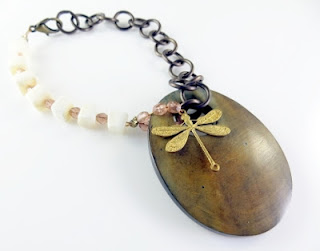From my last post, we learned that there are many styles of handmade designer jewellery for many moods, occasions, and outfits. We, as people, are diverse and our accessories tend to reflect that. Do you ever wonder, however, what our accessories reflect about us?
Jewellery by Kat on iCraft makes a lot of beaded charm bracelets. (See them at http://icraft.ca/jewelry-by-kat) What is the attraction to charms, I wonder? Dictionary.com defines charm, the trait, as “the power of pleasing” and charm, the object, as “something worn or carried on one’s person for its supposed magical effect”.
 |
| Silver Clover Leaf Necklace by DistinQue |
Apparently, the earliest known charms were carried to ward off evil back in the Neolithic era when hunters would carry interesting stones and trinkets for good luck. The Egyptian Age popularized the wearing of charms around the wrist or neck. Some charms were protective and woven in to their religious beliefs for the power of pleasing the gods. Others were status symbols and symbols of social belonging. Others yet were meant to be used in the afterlife to help identify who you were and guide you safely onward.
One of the most recognized “charms” of the modern age is the cross, as seen in Kat's Beaded Cross Necklace in Garnet. Me calling it a charm might sound offensive to some, but the cross of Christian religions is a symbol of belonging to a certain group, is it not? It is worn to show your faith: your belief in something extra-sensory that may bring you good fortune like the strength to carry on through hard times or the nobility to do the right thing, for example.
Charms, in fact, have played very prominent roles throughout the ages. Over a great period of time, however, the primary use of charms has changed. Queen Victoria is credited with re-popularizing charms as status symbols and aesthetic trinkets.
Eventually, charms became widely commercialized from the elaborate to the plastic gumball machine kind. In the 1940’s, plastic charms for children were greatly popular. Children collected ones that came with candy, coveting the rare ones that were pop culture symbols like Disney characters. Kat, from Jewellery by Kat, believes that children’s attraction to charms stems from the fact that the charms are small and represent things in our world.
 |
| An example of a Little Girl's Red Beaded Charm Bracelet with lots of little charms of familiar objects. |
I argue, however, that wearing those symbols shows where you place your favour. Even in adulthood, this beaded charm bracelet with dragonfly charm by Kat shows outwardly that you like dragonflies or that dragonflies signify something of meaning to you.
So then, back to the original question: what do our accessories reflect about us? Kat finds that each charm is unique. “They all have something to say. Put them all together on charm bracelet and they have a story to tell.”
(Indeed. The popularity of commercialized charms with children soon evolved into bracelets that served as a record of a girl’s rite of passage from birth, to marriage, to motherhood.)
Kat thinks that the charms we choose do reflect our likes, just like colours and food. If our mood plays a role in our choice of daily accessory, then that accessory also serves as a sign board of how we are feeling that day. I’d bet this “cha cha bracelet” (found at http://icraft.ca/handmade/29523/cha-cha-bracelet-with-green-and-aqua-beads.php) in Kat’s jewellery shop reflects your flare. This beaded bracelet is popping with colour and shimmies and jingles like a dancer on your wrist. Surely, it is a symbol of extroversion? What do you think?
 |
| Beaded Cha Cha Bracelet with Green and Aqua Beads |
I know that, when I was younger, I was drawn to charm bracelets because it felt like I had a lot even though I had only one bracelet. I grew out of the over-stuffed charm bracelet phase. I do still like charms, though, only in smaller doses. I like them hanging from a bookmark or on the front of a photo album for example. Kat thinks that we never out-grow our love of charms, we only grow up.
Looking back now, perhaps some of the ancient belief in the charm as an object of good luck or protection is subconsciously ingrained in us from our Neolithic days and that extra sensory value of the charm rings truest with us as children. As we grow and mature, we are still attracted to charms but our deep seeded intuition becomes only a distant whisper.



Lisa I had no idea that there was such a history to charms. Thank you for the information. My first jewellery project was to deconstruct an old charm bracelet!
ReplyDeleteExcellent post, and I love the history lesson on charms.
ReplyDeleteLove your history on charms then and now
ReplyDeleteVery interesting post :)
ReplyDeleteI have inherited my moms charm bracelet, she only had one charm on it, I have added a few in her memory.
Love the piece with the dragonfly, that one is my very favorite I think. Love the then and now.
ReplyDeleteRuth
Love that dragonfly charm!
ReplyDelete